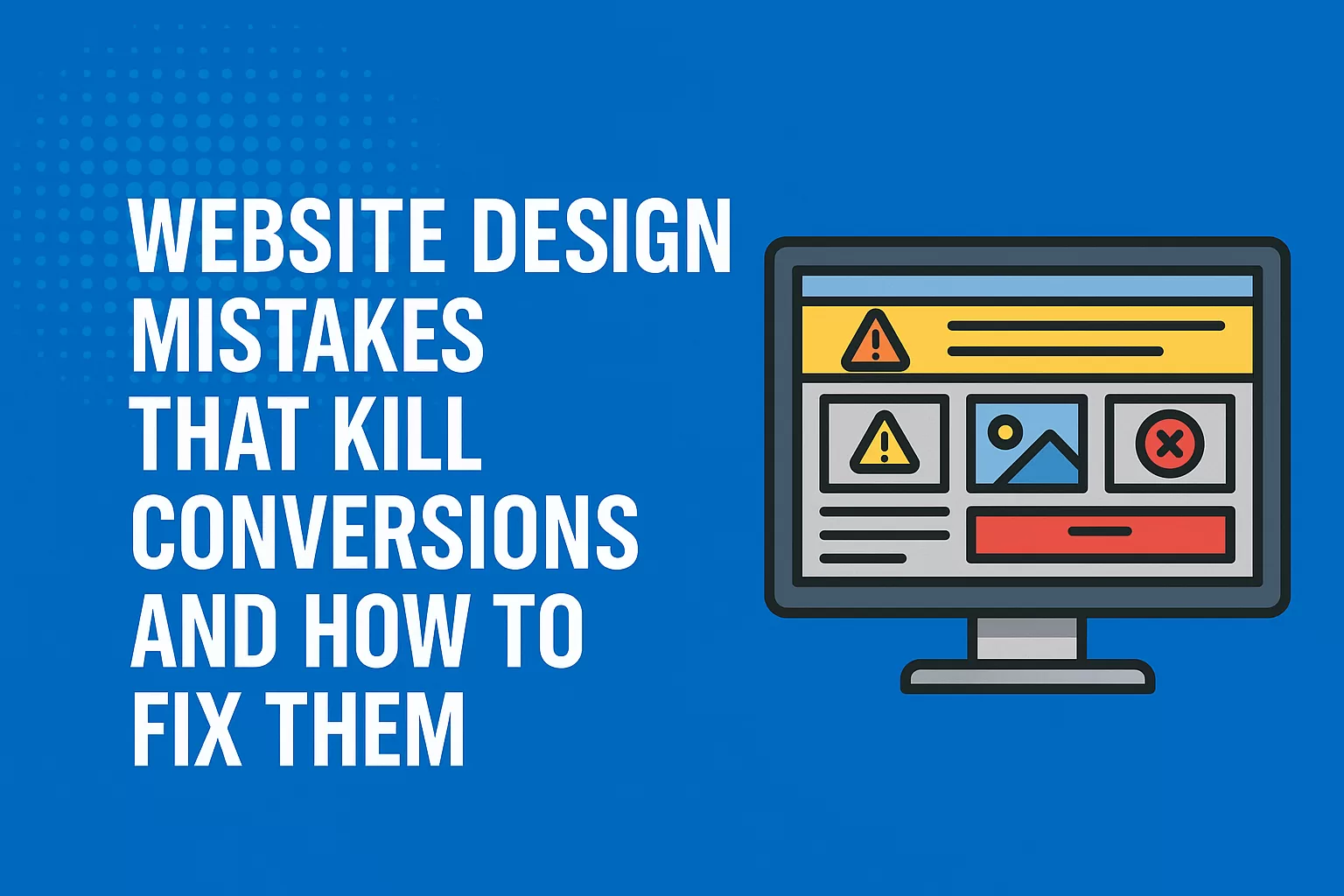Website Design Mistakes That Kill Conversions and How to Fix Them

Introduction
You’ve got traffic coming in. People are visiting your website. But... they’re not converting. What’s the problem?
Well, chances are your website design Mistakes is driving people away without you even realizing it. Small mistakes in design can have a massive impact on your conversion rates. Let’s break down the biggest website design mistakes and how you can fix them to actually improve website conversions starting today.
Why Website Design Mistakes Matters More Than Ever in 2025
The Psychology of First Impressions
It takes less than a second for users to form an opinion about your site. That quick judgment affects whether they’ll stay or bounce. A cluttered, outdated, or confusing layout? That’s a big nope from most users.
User Behavior and Bounce Rates
In 2025, users are more impatient than ever. If your site doesn't load fast, look good, or feel easy to use—they’ll leave. And once they’re gone, they probably won’t be back.
Most Common Website Design Mistakes to Avoid
1. Slow Loading Times
People expect a website to load in under 2 seconds. Anything more? You’re losing potential conversions.
Fix it: Compress images, use caching, choose a faster host, and minimize plugins.
2. Poor Mobile Responsiveness
Over 60% of web traffic is mobile. If your site isn’t responsive, you’re leaving money on the table.
Fix it: Use a responsive design, test across devices, and prioritize mobile-first layouts.
3. Cluttered Layouts
Too many elements crammed together overwhelm visitors.
Fix it: Embrace white space. Use a clean, organized layout with breathing room.
4. Confusing Navigation
If users can’t find what they’re looking for, they’ll leave. Simple as that.
Fix it: Use a clear, intuitive navigation menu. Group similar items. Include a search bar.
5. Low-Quality Visuals
Pixelated images and outdated design scream unprofessional.
Fix it: Use high-quality images and modern graphics. Stick to a consistent visual theme.
6. No Clear Call-to-Action (CTA)
Visitors won’t act if they’re not told what to do next.
Fix it: Make CTAs bold, simple, and obvious. Use action words like “Start Now” or “Get Your Free Quote.”
7. Pop-Up Overload
Nothing’s worse than five pop-ups before you even scroll.
Fix it: Use pop-ups sparingly. Time them well, and make them easy to close.
8. Bad Font Choices and Contrast
If your text is hard to read, no one will stick around.
Fix it: Use clear fonts, proper sizing, and good color contrast.
9. Autoplay Videos or Music
It’s 2025. Stop scaring visitors with sudden sound.
Fix it: Never autoplay. Let users choose to engage with video/audio.
How These Website Design Mistakes Impact Conversions
Drop in User Trust
Your website reflects your brand. A poorly designed site feels sketchy and untrustworthy.
Increased Bounce Rate
Design flaws drive users away quickly. This tells Google your site isn’t valuable, which kills your SEO.
Missed Sales Opportunities
Every confused user or annoyed visitor is a lost sale or lead.
SEO Consequences
Bad UX and slow load times hurt rankings, making it harder for new users to even find you.
How to Improve Website Conversions by Fixing These Design Issues
Speed Optimization Tips
- Compress and lazy-load images
- Use a CDN
- Minify CSS, HTML, and JavaScript
- Choose a fast, reliable web host
Mobile-First Design Principles
- Design for the smallest screen first
- Use responsive frameworks like Bootstrap
- Keep navigation thumb-friendly
- Avoid large text blocks on mobile
Simplifying Layouts
- Use grids for structure
- Remove unnecessary widgets or links
- Focus each page on one primary goal
Streamlining User Journeys
- Map out common paths (home → service → contact)
- Reduce the number of clicks to reach a goal
- Make forms short and simple
Designing Powerful CTAs
- Use action-based language
- Make buttons stand out
- Place CTAs above the fold
- Repeat CTAs on longer pages
Enhancing Visual Hierarchy
- Use headings and subheadings correctly
- Highlight key content with color or size
- Guide eyes with directional elements like arrows
Tools to Test and Improve Your Website Design
Google PageSpeed Insights
Get a full performance report and suggestions for improvement.
Hotjar
Heatmaps and session recordings show how users interact with your site.
A/B Testing Tools
Try Google Optimize or Optimizely to test different versions of your pages.
Mobile Emulator Tools
Test your design on various screen sizes using Chrome DevTools or BrowserStack.
Case Study: How a Website Redesign Boosted Conversions by 40%
A Chicago-based eCommerce brand redesigned their outdated website in 2024. They:
- Reduced page load time from 6s to 1.8s
- Simplified navigation and added product filters
- Replaced all CTAs with bold, contrasting buttons
- Switched to mobile-first layout
Result? Their conversion rate jumped from 1.6% to 2.3%—a 40% increase within 60 days.
Final Thoughts on Website Design and Conversions
Your website is your digital storefront. If it's messy, slow, or hard to use, people won’t stick around—let alone buy.
Avoiding common website design mistakes and focusing on improving UX will help boost conversions in a big way. Take the time to audit your site and fix what’s broken—your bottom line will thank you.
FAQs
What is the biggest website design mistake?
Not having a clear CTA. If users don’t know what to do next, they won’t do anything.
How do I know if my website is hurting conversions?
Look at your bounce rate, session duration, and heatmaps. Tools like Hotjar or GA4 help identify issues.
Can a redesign really improve sales?
Yes! A focused redesign can increase trust, guide users better, and lead to more conversions.
What tools help identify website problems?
Google PageSpeed Insights, Hotjar, GTMetrix, and user testing platforms like Maze.
How often should I update my site design?
Every 2–3 years or when your bounce rate increases or tech standards change.
If you're serious about boosting your website's performance, the smallest design change can make the biggest impact. From fixing broken CTAs to simplifying your layout, it's all about removing friction and making it easy for visitors to act. Want to make sure you're on the right path with your web strategy? Get in touch with us — we’d love to help you avoid costly website design mistakes and improve your conversions.

